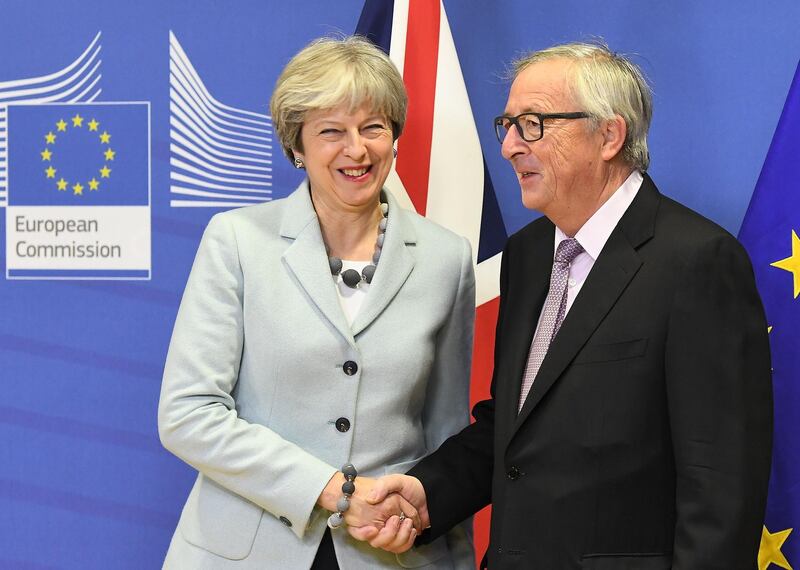After months of bitter confrontation, treachery, intrigue and political infighting, Britain has finally secured agreement on the first stage of its negotiations to leave the European Union. That was the easy bit.
“Let us remember that the most difficult challenge is still ahead,” said Donald Tusk, the head of the European Council. "We all know that breaking up is hard, but breaking up and building a new relation is much harder.”
It has taken 18 months since Britain voted in a referendum to leave the European Union to reach this stage. The sides will have just 15 months to agree, complete and deliver the treaty before Britain ends its 44-year stretch within the European Union and take substantial steps towards securing a major UK-EU trade deal.
Whether or not a deal is secured on the eventual terms of British’s withdrawal by all the players involved – including the dozens of national parliaments who will have a say – the UK will leave the European Union at 11pm on March 29, 2019.
Despite Friday’s breakthrough, talks on any trade deal may not start for months. EU officials hope to start discussions early next year on the transition deal demanded by UK business that would soften the impact of Britain’s departure from the European Union. That deal would mean that all EU rules and regulations would continue to apply to the United Kingdom until 2021, when the new relationship properly begins.
Even given the extra breathing space, it makes for a packed timetable with key issues still remaining outstanding after Friday’s deal on the rights of EU citizens in the UK, the state of the Irish border and the size of the divorce bill.
Analysts said that the deal struck Friday lessens the likelihood of a disorderly Brexit in which the UK drops out of the EU without any lasting deal on the future relationship between the two sides.
It also suggests that any lingering hopes for those wishing for a dramatic abrupt about-turn to remain in the EU are even more distant. But the deal represented a political effort to get things done rather than hammer out all of the detail and some of the most difficult issues were kicked down the road to consider at a future date. Apparent contradictions over the Irish question remain in the 15-page document.
“As the old saying has it, nothing is agreed until everything is agreed,” said Professor Anand Menon, director of ‘The UK in a Changing Europe’ thinktank. “Significant progress has clearly been made…. but let’s not kid ourselves. Problems remain.
“The Irish circle remains to be squared and at some point it will become clear that we can’t use cash to get a good trade deal. Overall my sense is this progress report reduces the chance of both no deal and no Brexit.”
____________
Read more:
[ Breakthrough in Brexit deal clears way for trade talks ]
[ RBS, Lloyd's of London say Brexit breakthrough won't change Brussels subsidiary plans ]
____________
Analysts were divided on whether Friday’s deal would spur Britain to seek trade deals outside of the European Union.
"If Britain hadn't secured this breakthrough with the EU, it would've started looking further afield for trade deals, such as with Asia, the Middle East and America," one trade expert told The National. "The upshot of Friday's developments is that all the UK's energy will now be focused on getting a deal with the EU."
But Shanker Singham, of the Legatum Institute thinktank, said that the deal meant that Britain was now free to pursue trade deals with other countries. “The worst thing the UK could do is say ‘we’re going to deal with the EU first, and then with all the other countries, because that will guarantee a bad result for the UK.”
Domestically, the deal on Friday was celebrated as a triumph for Theresa May, the under-fire British prime minister, who has defied predictions of her imminent demise since her plan backfired to strengthen her position before Brexit talks by calling early elections.
She had come under mounting pressure following a failed attempt to secure the deal on Monday from both inside and outside of her party, which is split on the extent to which the UK should sever its links with the European Union after 2019.
Today’s Brexit deal delivers:
— Theresa May (@theresa_may) December 8, 2017
- No hard border in Northern Ireland
- Secures a good financial deal for British taxpayers meaning more money for our priorities like housing, schools, and the NHS
- Secured the rights of EU citizens living here, and UK citizens living in the EU pic.twitter.com/h4QtXdwnFv
Mrs May – who backed remaining in the EU before the referendum – was supported by senior pro-Brexit colleagues Boris Johnson, the foreign secretary, and Michael Gove, the environment secretary, who ran against her in her party’s 2016 leadership election.
But the views of the pro-Brexiteers in her party were not matched by those from the main body that pushed for departure from the EU, who called for further upheaval within the divided Conservative Party to push for her ouster.
“Under Theresa May, we are leaving the European Union in name only,” said the millionaire backer of the campaign Arron Banks. “If anyone in the Conservative Party has any integrity or sense of duty left, we call on them now to save Brexit by triggering a leadership contest.”
But her position was bolstered after the business community gave a qualified welcome to the deal and the small Northern Irish party which props up Mrs May’s government, and whose intervention caused the collapse of the talks on Monday, also said it was happy with the final approved deal, despite some reservations.
Another potential hurdle was crossed when Guy Verhofstadt, the former Belgian premier and head of the European parliament’s Brexit group, said that he would recommend that European lawmakers back the deal but laid five down conditions to be resolved before a full withdrawal agreement was reached.
A group representing Britons living abroad had encouraged the parliament to defy Mr Verhofstadt and reject the deal. “If it takes 18 months to produce something this bad then imagine what’s going to happen once citizens’ rights get buried under all the trade arguments about airline slots and fish carcasses,” said Jane Golding of the group, British in Europe.
The document released Friday appears to contain a series of contradictions that could bedevil talks in the coming months. It confirms that the UK government has committed to leaving the internal single market and customs union – the tariff-free trading zone that is the centre-piece of the European project – that will allow it to set its own trade rules and strike agreements with other countries.
But debate has centred around paragraph 49 of the document which promises that the UK will “maintain full alignment with those rules of the Internal Market and the Customs Union” on the island of Ireland if no all-encompassing trade deal can be struck. The statement has the potential to keep debate rumbling over whether the government’s commitment to leaving the customs union will be maintained.
The UK has agreed a role for the European Court of Justice – the EU’s top judicial body – for up to eight years after Brexit.
The court has been a particular bugbear for the Brexit camp which says it interferes with British sovereignty because its rulings are binding on the UK. The Government said the measure would be limited, and apply to only a few cases each year. “This rules out anyone suing the UK in the European Court of Justice,” said Justice Minister Dominic Raab.





